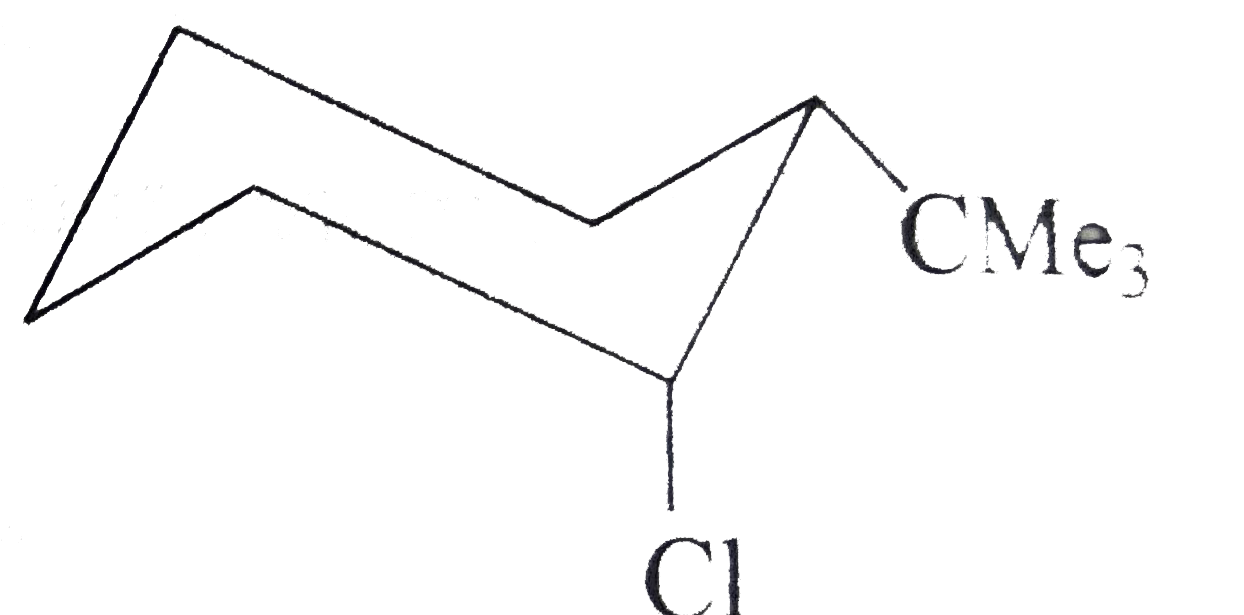Which of the following halides undergo E2 elimination?




The correct Answer is:A, B
To determine which of the given halides undergo E2 elimination, we need to understand the mechanism of E2 elimination and the structural requirements for it to occur.
1. Understanding E2 Elimination:
- E2 elimination is a bimolecular elimination reaction where a leaving group (halide) and a hydrogen atom are removed from adjacent carbon atoms, resulting in the formation of a double bond.
- The elimination occurs in an anti-coplanar fashion, meaning that the leaving group and the hydrogen must be on opposite sides (anti) of the molecule.
2. Identifying the Halides:
- We need to analyze the structures of the halides provided in the question. Typically, these will be alkyl halides with halogens like Cl, Br, or I attached to them.
3. Analyzing Each Halide:
- For each halide, identify the alpha (the carbon attached to the halide) and beta (the adjacent carbon) positions.
- Check if there is a hydrogen atom on the beta carbon that is in the anti position to the halide.
4. Example Analysis:
- Halide 1 (e.g., R-Br):
- If there is a hydrogen on the beta carbon that is anti to the bromine (Br), then E2 elimination can occur.
- Halide 2 (e.g., R-Cl):
- Similarly, check if there is a hydrogen on the beta carbon that is anti to the chlorine (Cl).
- Halide 3 and 4:
- If the hydrogens on the beta carbon are not in the anti position to the halide, E2 elimination cannot occur.
5. Conclusion:
- After analyzing all the halides, we conclude which ones can undergo E2 elimination based on the presence of anti hydrogens relative to the leaving group.
Final Answer:
- Based on the analysis, the halides that can undergo E2 elimination are Halide 1 and Halide 2.
- E2 elimination is a bimolecular elimination reaction where a leaving group (halide) and a hydrogen atom are removed from adjacent carbon atoms, resulting in the formation of a double bond.
- The elimination occurs in an anti-coplanar fashion, meaning that the leaving group and the hydrogen must be on opposite sides (anti) of the molecule.
- We need to analyze the structures of the halides provided in the question. Typically, these will be alkyl halides with halogens like Cl, Br, or I attached to them.
- For each halide, identify the alpha (the carbon attached to the halide) and beta (the adjacent carbon) positions.
- Check if there is a hydrogen atom on the beta carbon that is in the anti position to the halide.
- Halide 1 (e.g., R-Br):
- If there is a hydrogen on the beta carbon that is anti to the bromine (Br), then E2 elimination can occur.
- Halide 2 (e.g., R-Cl):
- Similarly, check if there is a hydrogen on the beta carbon that is anti to the chlorine (Cl).
- Halide 3 and 4:
- If the hydrogens on the beta carbon are not in the anti position to the halide, E2 elimination cannot occur.
- After analyzing all the halides, we conclude which ones can undergo E2 elimination based on the presence of anti hydrogens relative to the leaving group.
- Based on the analysis, the halides that can undergo E2 elimination are Halide 1 and Halide 2.
Topper's Solved these Questions
- HALIDESBook:HIMANSHU PANDEYChapter:HALIDESExercise:More Than One Correct (Q.26 To Q.50)
Explore 25 Videos
- HALIDESBook:HIMANSHU PANDEYChapter:HALIDESExercise:Linked Comprehension Type (Q.1 To Q.25)
Explore 25 Videos
- HALIDESBook:HIMANSHU PANDEYChapter:HALIDESExercise:Level 2 (Q.151 To Q.165)
Explore 15 Videos
- GENERAL ORGANIC CHEMISTRYBook:HIMANSHU PANDEYChapter:GENERAL ORGANIC CHEMISTRYExercise:Subjective Type Problems
Explore 19 Videos
- ISOMERISMBook:HIMANSHU PANDEYChapter:ISOMERISMExercise:Subjective Type Problems
Explore 11 Videos
Similar Questions
Knowledge Check
Which of the following halide is 2 ? .
AIsopropyl chlorideBIsobutyl chlorideCn -propyl chlorideDn-butyl chlorideWhich of the following most readily undergoes E2 elimination with a strong base?
A2-BromopentaneB2-Bromo-2-methylbutaneC1-Bromo-2,2-dimethylpropaneD2-Bromo-3-methylbutaneWhich of the following cannot undergo E2 reaction ?
A B
B C
C DNone of these
DNone of these
Which of the following will undergo fastest elimination with alcoholic KOH ?
View SolutionWhich of the following readily undergoes elimination reaction under basic conditions?
View SolutionAryl halide undergo :
View SolutionWhich of the following alkyl halides will undergo SN1 reaction most readily?
View SolutionWhich of the following alkyl halides will undergo SN1 reaction most redily ?
View Solution

